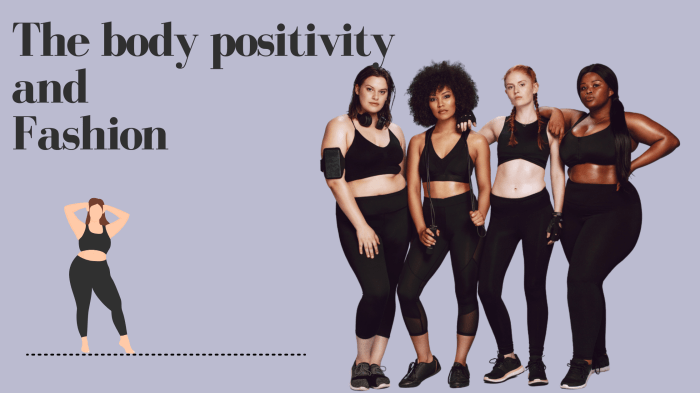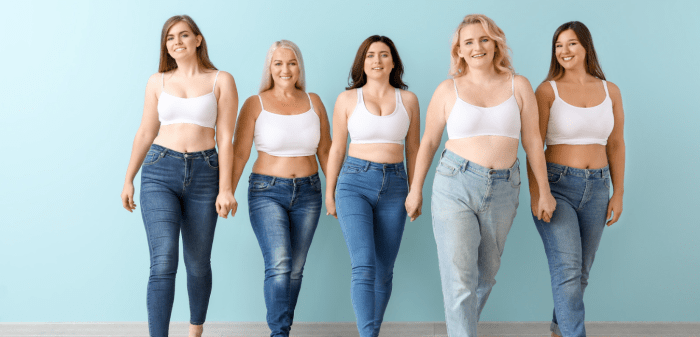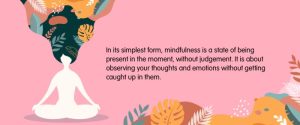
Ever felt the pressure to conform to an unrealistic beauty standard? We’re diving deep into the world of Body Positivity & Health, exploring how self-acceptance and self-love can revolutionize your well-being. Forget the scales and restrictive diets; this isn’t about achieving a specific look, but about fostering a healthier relationship with your body, mind, and spirit. Get ready to challenge societal norms and embrace a more compassionate approach to health!
This journey will uncover the multifaceted nature of body positivity, examining its impact on mental and physical health, while also addressing the common misconceptions and challenges. We’ll navigate the influence of societal pressures, media portrayals, and social media, providing practical strategies to navigate these complex landscapes. From understanding the connection between body positivity and healthy lifestyle choices to exploring specific health concerns faced by women, we’ll cover it all.
Prepare to embark on a transformative exploration of self-acceptance and a healthier, happier you.
Defining Body Positivity and its Relationship to Health
Body positivity is more than just a trend; it’s a complex movement impacting how we perceive ourselves and our well-being. It’s about fostering a healthier relationship with your body, regardless of its shape or size. This involves challenging societal beauty standards and embracing a more inclusive and accepting view of diverse bodies. Understanding its multifaceted nature and its connection to both mental and physical health is crucial for navigating this evolving landscape.
The Multifaceted Nature of Body Positivity
Body positivity isn’t a singular concept; it encompasses a spectrum of perspectives. Self-acceptance involves acknowledging and appreciating your body without judgment, recognizing its strengths and limitations. Self-love goes a step further, fostering a deep sense of care and affection for your physical form. Body neutrality, on the other hand, focuses on appreciating your body’s functionality and capabilities without necessarily assigning emotional value to its appearance.
These interconnected aspects contribute to a holistic approach to body image.
Benefits of Body Positivity on Mental and Physical Health
Embracing body positivity has significant implications for both mental and physical well-being. Mentally, it can lead to reduced anxiety and depression associated with body image issues. Studies show that individuals who practice self-acceptance report higher levels of self-esteem and improved body satisfaction. This positive mental state can, in turn, positively influence physical health by reducing stress-related illnesses and promoting healthier lifestyle choices.
For example, someone who feels comfortable in their body is more likely to engage in regular physical activity, enjoying the process rather than viewing it as a means to achieve a specific body type.
Challenges and Misconceptions Surrounding Body Positivity
Despite its benefits, body positivity faces several challenges and misconceptions. One common misunderstanding is that it promotes unhealthy behaviors. In reality, body positivity is not about ignoring health concerns; it’s about promoting health and well-being in a way that is inclusive and respectful of all body types. Another challenge is the potential for backlash, as some perceive it as promoting unhealthy lifestyles or disregarding the importance of health.
This highlights the need for clear communication and education to accurately represent the principles of body positivity. Furthermore, the movement is not without its internal criticisms, with some arguing that it can inadvertently exclude individuals who experience body dysmorphia or other body image disorders.
Comparison of Body Positivity with Other Health and Wellness Approaches
Body positivity differs from other approaches like diet culture, which often focuses on restrictive eating and achieving a specific body ideal. Unlike diet culture’s emphasis on weight loss and body modification, body positivity emphasizes self-acceptance and appreciation regardless of size or shape. It also contrasts with approaches that prioritize solely physical fitness, acknowledging that health and well-being are multifaceted and include mental and emotional aspects.
Body positivity integrates these aspects, advocating for a holistic and inclusive approach to health.
Comparison of Body Image Perspectives
The following table compares different body image perspectives:
| Perspective | Core Beliefs | Potential Benefits | Potential Drawbacks |
|---|---|---|---|
| Body Positivity | Self-acceptance, self-love, appreciation of all body types | Improved self-esteem, reduced anxiety and depression, healthier lifestyle choices | Potential for misinterpretation, challenges in addressing health concerns |
| Body Neutrality | Appreciation of body’s functionality, detachment from emotional value of appearance | Reduced focus on appearance, improved body function | May not address emotional aspects of body image |
| Thin Ideal | Belief that thinness is the most desirable body type | (None – this perspective is generally detrimental to health) | Increased risk of eating disorders, low self-esteem, body dissatisfaction |
The Impact of Societal Pressures on Body Image and Health

Societal pressures significantly influence our perceptions of our bodies and contribute substantially to both positive and negative body image. These pressures, often stemming from unrealistic beauty standards perpetuated by various media, can have profound effects on mental and physical health. Understanding these influences is crucial to fostering a more positive and accepting relationship with our bodies.
Various Societal Pressures Contributing to Negative Body Image
The relentless pursuit of unrealistic beauty ideals is driven by a complex interplay of factors. Advertising, fashion, and entertainment industries consistently portray idealized body types, often digitally altered to achieve unattainable perfection. This constant bombardment creates a skewed perception of what constitutes “normal” or “desirable,” leaving many individuals feeling inadequate and dissatisfied with their own bodies. Furthermore, cultural norms and family dynamics also play a significant role, with certain cultures placing greater emphasis on specific body types or features than others.
This can lead to internalized pressure to conform, particularly among younger individuals navigating their identity and self-esteem. Peer pressure, particularly in adolescence, adds another layer of complexity, with individuals feeling pressured to meet certain standards to fit in or gain social acceptance.
Examples of Media Representations Promoting Unrealistic Body Ideals
Consider the ubiquitous use of photo editing software in magazines and advertisements. Images are routinely altered to create impossibly thin models with flawless skin and perfect features. This creates a disconnect between the reality of the average person’s body and the unrealistic standards presented as the norm. Similarly, many films and television shows perpetuate these unrealistic ideals, often casting actors and actresses who embody these narrow beauty standards.
This constant exposure reinforces the idea that achieving happiness and success is contingent upon possessing a particular body type, leading to feelings of inadequacy and self-doubt in those who do not fit the mold. Even children’s media can subtly promote unrealistic body standards, contributing to the development of negative body image from a young age.
The Role of Social Media in Shaping Body Image and Self-Esteem
Social media platforms, while offering opportunities for connection and community, also present significant challenges to body image. The curated nature of online profiles often presents an idealized version of reality, showcasing only the most flattering aspects of individuals’ lives and appearances. The prevalence of filters and editing tools further exacerbates this issue, creating a constant stream of digitally enhanced images that can be detrimental to self-esteem.
Furthermore, the comparative nature of social media, where users can easily compare themselves to others, can fuel feelings of inadequacy and insecurity. The relentless pursuit of likes and validation can also contribute to a cycle of self-criticism and body dissatisfaction.
Strategies for Mitigating the Negative Effects of Societal Pressures on Body Image
Developing strategies to counter the negative impacts of societal pressures is crucial for fostering a healthy relationship with one’s body. This involves actively challenging unrealistic beauty standards by seeking out diverse representations of beauty in media and celebrating body diversity. Limiting exposure to social media and engaging in mindful media consumption can also help reduce the negative influence of unrealistic ideals.
Focusing on self-compassion and practicing self-care are essential for building self-esteem and fostering a positive body image. Seeking support from friends, family, or mental health professionals can provide guidance and encouragement during challenging times. Finally, advocating for a more inclusive and diverse representation of bodies in media and popular culture is a collective responsibility.
Infographic: The Cycle of Negative Body Image Influenced by Societal Pressures
The infographic would be a circular diagram. The center would depict a person feeling unhappy with their body. Arrows would radiate outwards to various societal pressures: “Unrealistic Media Portrayals” (showing a digitally altered image of a model), “Social Media Comparisons” (showing a phone screen with multiple filtered images), “Cultural Beauty Standards” (showing diverse cultural representations, but with a clear emphasis on one specific ideal), and “Peer Pressure” (showing a group of people conforming to a specific appearance).
These arrows would loop back to the center, creating a continuous cycle. The arrows would be labeled with the negative emotional responses they evoke: “Self-Doubt,” “Anxiety,” “Body Shame,” and “Low Self-Esteem.” The overall design would be in muted colors, to reflect the often somber and isolating feelings associated with negative body image. The circle’s border would be broken at one point, showing a path leading out, labeled “Strategies for Positive Body Image” (including positive self-talk, self-care, seeking support, and challenging unrealistic beauty standards).
Body Positivity and Health Behaviors
Body positivity, the practice of appreciating and accepting your body regardless of its shape or size, has a profound impact on health behaviors. Contrary to popular belief, it’s not about ignoring health or encouraging unhealthy habits; instead, it fosters a mindset that supports sustainable and positive changes. This approach shifts the focus from external pressures and restrictive diets to internal well-being and self-care, leading to healthier choices.
The Correlation Between Body Positivity and Healthy Lifestyle Choices
A positive body image is strongly linked to healthier lifestyle choices. When individuals feel good about themselves, they’re more likely to prioritize their well-being. This translates into increased motivation to engage in activities that nourish their physical and mental health. Studies show a positive correlation between self-acceptance and engagement in regular physical activity, healthy eating habits, and stress management techniques.
For instance, someone who embraces their body is more likely to choose a brisk walk over sitting on the couch, not because they want to lose weight, but because they want to feel energized and connect with their body in a positive way.
Body Positivity’s Influence on Exercise and Nutrition Plans
Body positivity significantly impacts adherence to exercise and nutrition plans. Traditional weight-loss approaches often rely on restrictive diets and intense exercise regimens, which can lead to burnout, disordered eating, and ultimately, failure. In contrast, a body-positive approach emphasizes sustainable lifestyle changes that align with individual preferences and capabilities. Instead of focusing solely on weight loss, the emphasis is on finding activities that bring joy and improving overall well-being.
This approach increases the likelihood of long-term commitment and success. For example, someone might choose yoga because they enjoy it, rather than forcing themselves into a high-intensity workout they dread. Similarly, they might focus on incorporating more fruits and vegetables into their diet because they enjoy the taste and how it makes them feel, not because they feel pressured to restrict calories.
Comparing Body Positivity and Traditional Weight-Loss Methods
Traditional weight-loss methods often prioritize weight loss as the ultimate goal, often employing restrictive diets and intense exercise. This can lead to a negative cycle of guilt, shame, and self-criticism if progress isn’t immediate or significant. In contrast, body positivity promotes a holistic approach, focusing on overall health and well-being, rather than just a number on the scale. It encourages self-compassion and emphasizes the importance of respecting individual differences.
The ultimate goal is to develop a healthy relationship with one’s body and to prioritize self-care. While weight loss may occur as a side effect of healthy lifestyle choices, it’s not the primary focus.
Body Positivity and Enhanced Motivation and Self-Efficacy
Embracing body positivity boosts motivation and self-efficacy in achieving health goals. When individuals accept and appreciate their bodies, they are more likely to engage in self-care activities that promote well-being. This increased self-esteem translates into greater confidence in their ability to make positive changes and stick to them. For example, someone who practices self-compassion is more likely to forgive themselves for occasional setbacks and continue working towards their goals.
They understand that progress isn’t linear and that setbacks are a normal part of the process.
Practical Tips for Promoting a Positive Body Image and Healthy Behaviors
Developing a positive body image and adopting healthy behaviors requires consistent effort and self-compassion. Here are some practical steps:
- Practice self-compassion: Treat yourself with the same kindness and understanding you would offer a friend.
- Challenge negative self-talk: Replace critical thoughts with positive affirmations.
- Focus on what your body can do: Appreciate its strength and capabilities.
- Engage in activities you enjoy: Prioritize movement and nutrition that bring you pleasure.
- Surround yourself with positive influences: Seek out supportive friends, family, and communities.
- Limit exposure to unrealistic media portrayals: Be mindful of the images you consume and challenge unrealistic beauty standards.
- Celebrate your achievements: Acknowledge your progress, no matter how small.
Women & Health

Women’s experiences with body image and health are uniquely shaped by biological, social, and cultural factors. Understanding these complexities is crucial for promoting well-being and addressing health disparities. This section explores the specific challenges women face, focusing on the interplay between body positivity and various health concerns throughout their lives.
Hormonal Changes and Body Image Across the Lifespan
Hormonal fluctuations significantly impact a woman’s body throughout her life, influencing both physical appearance and self-esteem. Puberty, menstruation, pregnancy, and menopause each bring distinct hormonal shifts that can affect weight, body composition, and skin. These changes can trigger emotional responses, impacting body image and potentially leading to feelings of inadequacy or anxiety if societal beauty standards are not inclusive of these natural variations.
For example, the weight gain associated with pregnancy can be a source of stress for some women, even though it’s a natural and healthy process. Similarly, the hormonal shifts during menopause can lead to changes in body shape and weight distribution, which can be challenging to navigate in a culture obsessed with youthful appearance. Positive self-perception and acceptance of these natural changes are key to maintaining mental well-being during these transitional phases.
Body Positivity and Reproductive Health
Body positivity plays a vital role in fostering a positive relationship with one’s body, which is particularly important for reproductive health. A positive body image can encourage women to engage in self-care practices, seek preventative care, and openly communicate with healthcare providers about their reproductive health concerns. Conversely, negative body image can lead to avoidance of healthcare, delaying diagnosis and treatment of conditions like sexually transmitted infections (STIs) or gynecological cancers.
For example, discomfort with a pelvic exam might lead to a delay in seeking care, potentially worsening a health issue. Embracing body positivity helps to destigmatize these aspects of women’s health and encourages proactive care.
Specific Health Concerns Disproportionately Affecting Women
Several health conditions disproportionately affect women, often intertwined with body image issues. Eating disorders, such as anorexia nervosa and bulimia nervosa, are significantly more prevalent in women. These disorders are frequently linked to societal pressures to conform to unrealistic beauty standards. Polycystic ovary syndrome (PCOS), a hormonal disorder affecting ovulation, can lead to weight gain and irregular periods, significantly impacting body image and self-esteem.
Endometriosis, a condition where uterine tissue grows outside the uterus, can cause chronic pain and heavy bleeding, affecting both physical and mental health and often leading to feelings of isolation and low self-worth. Addressing these conditions requires a holistic approach that considers both the physical and psychological aspects, with body positivity playing a crucial role in promoting recovery and well-being.
Impact of Body Positivity on Women’s Health Conditions
| Condition | Challenges Related to Body Image | Benefits of Body Positivity | Strategies for Improved Well-being |
|---|---|---|---|
| Eating Disorders | Intense self-criticism, body dissatisfaction, distorted body image, fear of weight gain. | Improved self-acceptance, reduced body shame, increased self-compassion, healthier coping mechanisms. | Therapy, nutritional counseling, support groups, mindful eating practices, challenging negative self-talk. |
| PCOS | Weight gain, hirsutism (excess hair growth), acne, impacting self-confidence and body image. | Increased self-acceptance, reduced negative self-perception, improved self-care practices, empowerment to manage the condition. | Lifestyle changes (diet, exercise), medical management (medication), stress reduction techniques, seeking support from others with PCOS. |
| Endometriosis | Chronic pain, fatigue, impacting physical activity and self-esteem, feelings of isolation and low self-worth. | Increased self-compassion, improved self-care, reduced feelings of shame and isolation, acceptance of limitations, focus on strengths. | Pain management strategies (medication, physical therapy), lifestyle modifications, emotional support, open communication with healthcare providers. |
Promoting Body Positivity and Health in Diverse Communities
The body positivity movement, while gaining significant traction, faces a critical challenge: ensuring its message resonates and benefits all communities equally. True body positivity demands inclusivity, recognizing that diverse cultural backgrounds, ethnicities, sexual orientations, and abilities shape individual experiences with body image and self-perception. Failing to address these differences risks perpetuating existing inequalities and excluding those who need the movement’s support most.
Inclusivity and representation are not mere buzzwords; they are fundamental to the movement’s success. A body positivity movement that primarily showcases one type of body or one type of person ultimately reinforces the very exclusionary ideals it aims to dismantle. A truly effective approach requires acknowledging and celebrating the incredible diversity of human bodies and experiences.
The Importance of Inclusivity and Representation
Diverse representation within the body positivity movement is crucial for fostering a sense of belonging and validation among individuals from marginalized communities. When people see themselves reflected in the movement’s messaging, they are more likely to feel empowered to embrace their bodies. This includes representation in terms of race, ethnicity, size, ability, age, gender identity, and sexual orientation. For example, the lack of representation of plus-size Black women in mainstream media contributes to the feeling of invisibility and lack of validation for this demographic.
Conversely, initiatives showcasing diverse bodies build a powerful message of acceptance and self-love.
Examples of Initiatives Promoting Body Positivity Among Diverse Communities
Several organizations and initiatives are actively working to promote body positivity among diverse communities. For example, the National Eating Disorders Association (NEDA) offers resources and support specifically tailored to different racial and ethnic groups, acknowledging the unique cultural factors influencing body image. Similarly, organizations focusing on LGBTQ+ individuals are working to challenge the unrealistic beauty standards often imposed on this community, promoting self-acceptance and celebrating diverse body types.
Initiatives focusing on individuals with disabilities are also emerging, emphasizing the importance of body neutrality and self-acceptance regardless of physical limitations. These initiatives often utilize diverse media, such as social media campaigns featuring individuals from diverse backgrounds, community workshops, and culturally appropriate educational materials.
Cultural Norms and Values’ Influence on Body Image and Self-Perception
Cultural norms and values profoundly impact body image and self-perception. For example, in some cultures, a larger body size may be associated with wealth, fertility, and beauty, while in others, thinness is idealized. These varying cultural standards significantly influence how individuals perceive their own bodies and contribute to the development of body image issues. Understanding these cultural nuances is essential for developing culturally sensitive strategies for promoting body positivity.
For instance, a campaign promoting body positivity in a culture that values larger body sizes would differ significantly from a campaign targeting a culture that prioritizes thinness.
Culturally Sensitive Strategies for Promoting Body Positivity
Culturally sensitive strategies for promoting body positivity involve understanding and respecting the diverse cultural contexts in which individuals live. This includes using culturally appropriate language and imagery, engaging community leaders and influencers, and collaborating with cultural organizations. For example, a body positivity campaign targeting a specific ethnic community might involve using the language and imagery that resonates with that community, featuring community members as spokespeople, and partnering with local organizations to reach a wider audience.
This approach ensures that the message is relevant, relatable, and effective.
Resources and Organizations Promoting Body Positivity and Health in Diverse Communities
Several organizations actively work to promote body positivity and health within diverse communities. It’s crucial to support and engage with these resources for a more inclusive and effective movement.
- National Eating Disorders Association (NEDA): Offers resources and support for individuals of all backgrounds struggling with eating disorders.
- The Body Positive: Provides body image workshops and resources focused on empowerment and self-acceptance.
- National Association of Anorexia Nervosa and Associated Disorders (ANAD): Provides support and education related to eating disorders, including cultural considerations.
- Organizations focused on specific communities: Numerous organizations focus on specific communities, such as LGBTQ+ individuals, people with disabilities, or specific ethnic groups. Searching for organizations relevant to a specific community will yield valuable resources.
Closing Notes
Ultimately, Body Positivity & Health isn’t about achieving a perfect body, but about cultivating a positive and accepting relationship with the body you have. By challenging societal pressures, embracing self-compassion, and prioritizing holistic well-being, we can unlock a path toward greater self-esteem, improved mental and physical health, and a more fulfilling life. Remember, health is a journey, not a destination, and self-love is the compass guiding the way.
So, let’s celebrate our unique bodies and embark on this empowering journey together!
Key Questions Answered
What’s the difference between body positivity and body neutrality?
Body positivity actively celebrates all bodies, while body neutrality acknowledges and accepts your body without necessarily assigning positive or negative value to it.
Is body positivity just a trend?
No, it’s a movement that challenges harmful beauty standards and promotes self-acceptance, which is crucial for long-term well-being. While trends come and go, the need for self-love and acceptance is constant.
How can I practice body positivity if I’m struggling with a health condition?
Focus on what your body
-can* do, rather than solely on limitations. Celebrate small victories and seek support from healthcare professionals and support groups. Remember, self-compassion is key.
Can body positivity lead to neglecting health?
No. Body positivity encourages healthy habits from a place of self-respect, not self-criticism. It’s about making choices that nourish your body and mind, not about conforming to arbitrary ideals.





